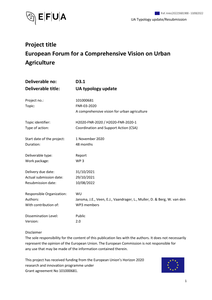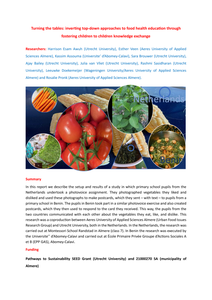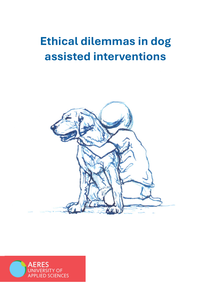Urban Agriculture (UA) is rapidly evolving and changing and often entails more than the production of food. EFUA’s Working Package 3 therefore aims to identify the types and benefits of UA in the European context. This report is an update of the typology as described in the COST Action UAE. As existing typologies are often based on subjective observation rather than on empirical data and are also one-dimensional, this study is based on a systematic literature review about characteristics and existing typologies of UA, interviews with sixteen experts in the field representing eleven European countries and a questionnaire about specific UA initiatives amongst 112 respondents.
MULTIFILE

In this report we describe the setup and results of a study in which primary school pupils from the Netherlands undertook a photovoice assignment. They photographed vegetables they liked and disliked and used these photographs to make postcards, which they sent – with text – to pupils from a primary school in Benin. The pupils in Benin took part in a similar photovoice exercise and also created postcards, which they then used to respond to the card they received. This way, the pupils from the two countries communicated with each other about the vegetables they eat, like, and dislike.
MULTIFILE

In 'Ecodemocracy in the Wild: If existing democracies were to operationalize ecocentrism and animal ethics in policy-making, what would rewilding look like?' Helen Kopnina, Simon Leadbeater, Paul Cryer, Anja Heister, and Tamara Lewis present a democratic approach to considering the interests of entities and the correlation of rights of nature within it. According to the authors , ecodemocracy's overarching potential is to establish the baseline principles that dethrone single species domination and elevate multiple living beings as stakeholders in all decision-making. They provide insights on how ecodemocracy could become manifest and what it takes to achieve mult-species justice. A unique contribution in this chapter is the notion of ecodemocracy in rewilding , exemplified bij the controversial Dutch rewilding experiment in Oostvaardersplassen. The authors discuss the complexities of decision-making in the interest of different species and the challenges that arise when implementing such politics.
MULTIFILE

If you are looking for examples of just how special dogs are, you will find thirteen wonderful examples in this book. These dogs have a knack for calming people down and picking up on tension—sometimes even better than we do! Each story highlights the incredible bond between dogs and humans, showcasing their unique talents. But there's more to it than just heartwarming tales.When dogs get involved in caregiving, it opens up a lot of questions and challenges. Some of these are more straightforward, like what health benefits come from having a dog around or how effective other methods are without using a dog. At the same time, the mix of caregiver, dog, and client brings up important questions about how to do the right thing, treat both people and animals well and evaluate various options available. That’s where ethics come into play—the core theme of this collection of stories. We’re not here to tell you what’s right or wrong; instead, we want to spark conversations about these topics. Ethics can be quite personal, but that doesn’t mean you have to tackle these decisions alone. By sharing experiences and discussing challenges, we can support each other and make better choices together.This collection of stories is part of a bigger two-year project that looks at how animal-assisted interventions affect the well-being of dogs. The research comes from the Human-Animal Interactions research group at Aeres University of Applied Sciences in Dronten, working alongside partners in the field, and was co-funded by the Regieorgaan SIA (Taskforce for Applied Research SIA), which is part of the Dutch Research Council (NWO). If you want to learn more about this research, check out the Human-Animal Interactions research group’s website.
MULTIFILE

Implementation of reliable methodologies allowing Reduction, Refinement, and Replacement (3Rs) of animal testing is a process that takes several decades and is still not complete. Reliable methods are essential for regulatory hazard assessment of chemicals where differences in test protocol can influence the test outcomes and thus affect the confidence in the predictive value of the organisms used as an alternative for mammals. Although test guidelines are common for mammalian studies, they are scarce for non-vertebrate organisms that would allow for the 3Rs of animal testing. Here, we present a set of 30 reporting criteria as the basis for such a guideline for Developmental and Reproductive Toxicology (DART) testing in the nematode Caenorhabditis elegans. Small organisms like C. elegans are upcoming in new approach methodologies for hazard assessment; thus, reliable and robust test protocols are urgently needed. A literature assessment of the fulfilment of the reporting criteria demonstrates that although studies describe methodological details, essential information such as compound purity and lot/batch number or type of container is often not reported. The formulated set of reporting criteria for C. elegans testing can be used by (i) researchers to describe essential experimental details (ii) data scientists that aggregate information to assess data quality and include data in aggregated databases (iii) regulators to assess study data for inclusion in regulatory hazard assessment of chemicals.
DOCUMENT

High consumption of animal-source foods, specifically meat, adversely affects human health and the environment. Dietary habits are shaped at younger ages and a reduction in meat consumption may be facilitated by the life course transitions in early adulthood, but studies are limited. This study among young Dutch adults aimed to describe their perceptions on the influence of life course transitions on meat consumption, barriers and enablers to reduce meat consumption, and strategies for reducing meat consumption. Barriers and enablers were grouped applying the COM-B model that includes capability, opportunity, and motivation. This quantitative cross-sectional study included a representative sample of 1806 young adults from two Dutch consumer panels who completed an online survey. Young adults frequently reported life course transitions, especially those related to moving house, to have decreased their meat consumption. Barriers and enablers to reduce meat consumption were identified for all three factors of the COM-B model. Important barriers included taste, perceived high prices of meat alternatives, and habits. In contrast, important enablers included care for the environment and animal welfare, enjoyment of smaller portions of meat and saving money. However, barriers and enablers largely differed by groups of meat consumption frequency. Self-perceived effective strategies for reducing meat consumption were price reduction of meat alternatives, recipes for vegetarian meals, and more attractive meat alternatives. The findings of this study are relevant for the development of targeted behaviour-change programmes including interventions in the physical and the social environment (like lowering prices and improving the offer of meat alternatives).
MULTIFILE

Carnitine/choline acyltransferases play diverse roles in energy metabolism and neuronal signalling. Our knowledge of their evolutionary relationships, important for functional understanding, is incomplete. Therefore, we aimed to determine the evolutionary relationships of these eukaryotic transferases. We performed extensivephylogenetic and intron position analyses. We found that mammalian intramitochondrial CPT2 is most closely related to cytosolic yeast carnitine transferases (Sc-YAT1 and 2), whereas the other members of the family are related to intraorganellar yeast Sc-CAT2. Therefore, the cytosolically active CPT1 more closely resembles intramitochondrial ancestors than CPT2. The choline acetyltransferase is closely related to carnitine acetyltransferase and shows lower evolutionary rates than long chain acyltransferases. In the CPT1 family several duplications occurred during animal radiation, leading to the isoforms CPT1A, CPT1B and CPT1C. In addition, we found five CPT1-like genes in Caenorhabditis elegans that strongly group to the CPT1 family. The long branch leading to mammalian brain isoform CPT1C suggests that either strong positive or relaxed evolution has taken place on this node. The presented evolutionary delineation of carnitine/choline acyltransferases adds to current knowledge on their functions and provides tangible leads for further experimental research.
MULTIFILE

Plant-based proteins, like water lentils, generally result in lower environmental impact compared to animal-based protein.
MULTIFILE
